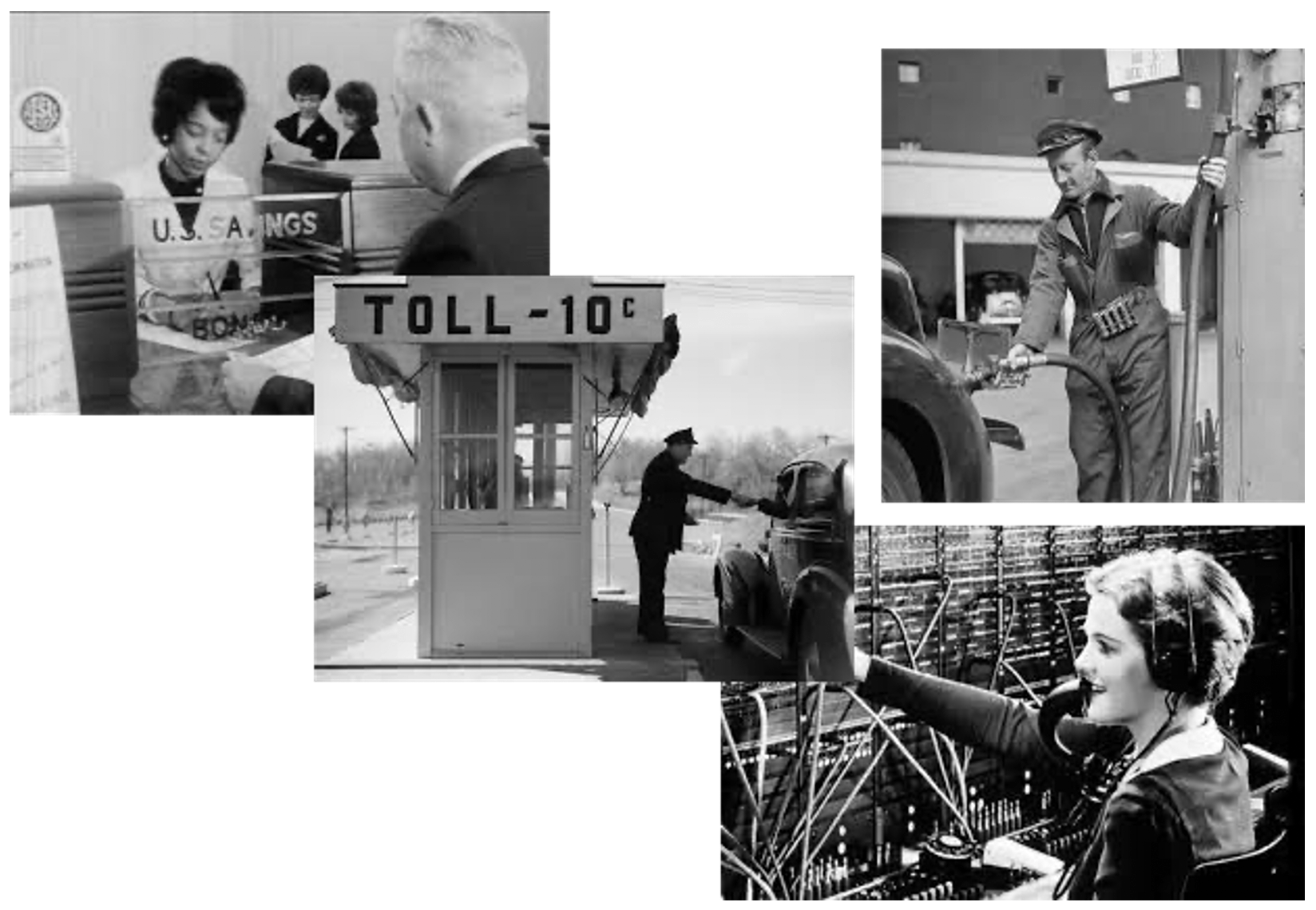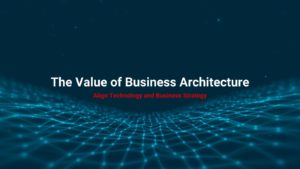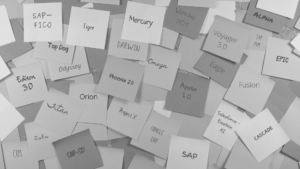REIMAGINING THE FRONTLINE WORKFORCE
This is the final post of a series, where I’ve been using the framework of WHY, WHAT, HOW, WHO from my book Blind Spot: A Leader’s Guide To IT-Enabled Business Transformation – enhanced with stories and analogies – to help business leaders to understand the Digital and IT transformation journey in very simple business terms.
I’m wrapping this series up with the WHO, in two parts. Part 7 was about Leadership (The Team with the Best Leadership Wins), and this, Part 8, is about the Workforce. In a world that is this dynamic and within a company that is innovative, the structure, leadership, culture, and workforce need to be continuously learning, leading, and adapting. You can’t have Business and Technical Agility if you have Organizational Rigidity or weakness.
Part 8: The WHO – Reimagining the Frontline Workforce
Business strategy has always been top-of-mind for Executive Teams and Boards. WHAT to do to compete in the future – new products, new channels, new geographies, adjacent businesses, market share, wallet share, etc. – are all in the context of a multi-year aperture. To get the business outcomes that are required to achieve profitable growth, they know they need to make strategic bets and take risks. For most of the 20th century, the overall time horizon was generally 5-7 years with updates and adjustments on an annual basis. That horizon and risk framework began to change with the advent of the internet in the late 90’s and the smartphone 10+ years ago. And, then, seven months ago, with the pandemic, it seems like we were all loaded into a “slingshot” and launched into an extremely uncertain future. It’s become difficult to predict the future when it feels unpredictable.
The reaction to the acceleration and growing uncertainty might be “business strategy must be dead, and we just need to be able to change as the world changes… right?”. That answer is more right than wrong – but, that in and of itself is the business strategy. A business model that is flexible, adaptable or “agile” is what will be required to survive and thrive in the future. Executive teams thinking about modern strategy need to think about WHAT will make us faster and more flexible, which is “Business Agility” (Part 2 of this series).
That means we need to invest in the ability to “sense-and-respond” in seconds, minutes, hours, days, weeks and months, not years and decades. To achieve that agility requires we break down the rigid walls and silos that are baked into our existing processes and systems. These have built up over decades of hardwiring business rules, process flows and data into generations of legacy systems. Therefore, the convergence of WHAT agility we have to achieve as a business and HOW we will architect our way out of rigidity is rapidly becoming the multi-year strategy to transform into a “digital business”.
If we’re successful in creating a true digital business that can compete in the future, that business, by definition, will require a very different workforce. The workforce will have to be different in numbers, skills, locations and culture. The reason I stress the CHRO partnership (see The CIO’s Two Best Friends Should Be The CFO And The CHRO) is that my history has shown me that in a true transformation the human element is the “long pole” in the tent. Particularly in union environments or in companies and countries with heavy regulatory mechanisms. The WHO plan needs to be woven into the multi-year business and technology roadmap for the journey. Unfortunately, this critical part of “Digital Transformation” is barely on the radar in most companies.
Over the decades, and in this series of blog posts, I’ve pushed for a multi-year plan instead of small aperture, annual project plans as a way to build the proper technology solutions. However, the multi-year plan is even more important to the workforce planning, especially this time around.
This is nothing new to transformation in any era, it’s just more pronounced. Let’s follow through with a couple of stories of the workforce transformations that I’ve personally been a part of. This will help illustrate what strong HR engagement and workforce change forethought can mean to business success.
Frito-Lay: Handheld Computers for 10,000 Route Salespeople
In the 1980s, the business strategy shift caused by the “Walmart effect” on retailers and consumer good companies was clear. We could no longer nationally price or promote our products. We needed to get technology, data, and pricing/promotion capabilities in the hands of our 10,000 route salespeople. The HOW was more difficult because there were no mobile devices commercially available and traditional networks couldn’t carry the load. However, with the business needs articulated, we worked with Fujitsu, IBM and Scientific Atlanta to figure out a solid, but primitive (by today’s technology) solution. So, we had the Business case; we had the Technical solution, but those weren’t all we needed.
This is when I got my PhD managing change. That lesson emanated from Wayne Calloway, Chairman and CEO of PepsiCo. Wayne “bounced” back to me a perfectly well articulated Capital Appropriation Request – TWICE. So, I flew to New York, sat on his couch, and flawlessly made the case for the handheld computer system. His reaction and his explanation for rejecting my proposal was:
“I know you know what to do and that you believe in the program, but you can’t change the workforce. This is not an IT project. It’s a business transformation. I’ll sign it when the business owners have your deep understanding, commitment, and passion.”
Wow! That was 40 years ago.
I went back to Dallas, got the business leadership involved, got approval, and got started. Since this was a cross-functional effort that connected Sales, Marketing, Manufacturing, Purchasing, and Distribution, they assigned a senior leader to manage the End-to-End transformation. I got what I asked for. But, to my surprise, as part of his “ownership”, he also wanted to manage me and my IT team. It was initially uncomfortable but eventually very productive.
The productive part came with the epiphany that we were going to deliver the IT stuff, but we still hadn’t answered who was going to lead all the other critical parts of the transformation – wiring the trucks for technology, training the salespeople, changing processes and work rules, adjusting compensation plans, and getting the field or frontline workforce to embrace the technology. When we really began to understand what it was going to take to make the real change required by that “Walmart effect” and our business strategy, we realized that there was actually more HR work and risk than concern about the technology part of what we were doing.
What was super critical to figure out was how 10,000 route drivers, who never heard of a mobile computer, would take these devices on their truck and interact with 300,000 skeptical store managers every day. We also had thousands of clerical people in Dallas whose jobs would probably go away when this was fully implemented. This was where the multi-year plan and early engagement of strong HR and a training group was critical.
Ultimately, we were successful at meeting this challenge – more because of the change leadership, and the rallying of the frontline workforce, than because of the technology. But it took a great deal of teamwork, an integrated business/technology/workforce roadmap, and some real creativity. Here are some clips from the training, internal change management, and testimonial videos that we used back then. I think you’ll enjoy seeing the fun and creativity we put into this. The first video is of William Shatner (yes, Captain Kirk!) talking about the impact technology has had and will have on people.
This second video is an excerpt of the WIFM “what’s in it for me (salesperson)” part of our internal change management campaign. (For those of you who might be interested in viewing the full video, click this link to view it in its entirety.)
Burlington Northern Santa Fe Railway (BNSF): The Scheduled Railroad
This was a little different. It was the merger of two railroads, that were each made up of 50 or more mergers over many decades, into one unified North American “scheduled railroad”. This required common end-to-end business processes and technology covering 40,000 miles of track. Again, the technology to pull off the business strategy was tough as we moved from local physical track management to centralized electronic switching, and from recording car movement by human visual sighting and keying to toll tag readers.
This was certainly challenging from a technology perspective, but the real difficulty was negotiating with dozens of unions across the workgroups and geographies in a recently deregulated industry. The industry had traditionally been very slow to change. For example, we still had a “fireman” on every train, even though locomotives had moved from wood to coal to diesel decades earlier.
This change wasn’t impossible, but it was hard, and required negotiations far in advance of the next contract. We couldn’t have just shown up in a rail yard one day and implemented the new system without the HR and Labor Relations teams having a multi-year runway.
Delta Air Lines: Gate and Boarding
At Delta, one of our big drivers for our Gate and Boarding initiative was to make the frontline employees more productive and efficient – and also happier in their jobs so they would be able to continue to enthusiastically serve our customers.
So, as we BEGAN the effort to redesign business processes and enable those new processes with technology, we engaged a team of 14 active gate agents, flight attendants, pilots, and baggage handlers on the INITIAL DESIGN. The CHRO and the EVP in charge of Airport Customer Experience had such great vision and commitment to get this right that they found a way to temporarily reassign those selected individuals to this work. This was a cross-functional, frontline team that was brought together to think outside of their normal functional “silo” and help innovate the entire process. They shared their first-hand knowledge and creative ideas all the way from design through to implementation and training their peers. At one point, we even had one of the gate agents present the business and technology solution to the Delta Board of Directors for investment approval. The new Gate and Boarding “system” was now their idea!
By engaging the frontline workforce early in the initiative, we ensured that we got the business and technology parts right. More importantly, we fostered the kind of co-ownership of the change that was required for true, successful transformation.
Dramatic Impact in the Modern Era
Now leap forward to today and the extreme pressure to build a digitally enhanced, “sense-and-respond” business model. The acceleration of the change that technology brings to the workforce, to how each of us lives and works, is dramatic. Ten years ago, if I said, “I ordered in lunch from Uber Eats on my iPhone so I could attend my Zoom meeting to discuss the results of my recent physical exam with my doctor via his new telemedicine app”, it would have sounded crazy. But that’s where we are today. After 55 years in business, my working life has totally changed. Instead of wearing a blue suit, white shirt and red tie to jump on a plane, stay in a hotel, and actually talk to people in person while I draw on a whiteboard, I’m now attending meetings on Zoom in my workout clothes and writing blogs. It’s STUNNING and EXCITING for me.

It might not be so exciting if you’re a frontline person in retail, restaurants, airline, factories, banking, etc. It might be scary for them; It might even be an existential threat to their career and livelihood. There WILL be a frontline workforce in those industries, but those workforces will be vastly reshaped with regard to skills, locations, and numbers. That reshaping, or transformation, needs to be thoughtfully planned, communicated, and executed “in-line” with the business and technology roadmap – not done haphazardly as an afterthought. In fact, this time the impact and collateral effects won’t stop at the boundaries of your companies. It will be heavily influenced by the industry ecosystems that our enterprise is a part of. For example, changes in technology enabled business models will not just affect the Frito-Lay workforce in isolation. The impact will be felt all around Frito’s value chain – back into the supply chains and logistics providers involved in making and moving the product, forward to the retailers that are Frito’s customers and all the way out to the consumer (the people that actually buy and eat the product).
Think about a past world that had gas station attendants that would pump your gas; think about stopping in a tollbooth on some highways to hand a person actual money to pay a fee; think about going into a bank on a Friday to deposit your paycheck with a bank teller. I could name 50 different activities that have almost completely evaporated over the last few decades. How we buy cars, airline tickets, groceries, clothes, furniture, etc. will continue to change as digital technology becomes more pervasive and expected.

The difference now is that our workforces don’t have time to adjust organically. When change happens in days, weeks, months, and years – instead of decades and generations – we’ve got to add this third lane to any transformation plan, and it’s got to be a Business, Technology, AND Organization multi-year plan for it to work.
We no longer live, work and compete in isolation. So, what is the workforce going to look like in 5-10 years? Who will be retiring and who will be joining? What will the K-12 and university systems enable in the next generation workforce? How will people make a living and be able to afford new products and services? I could go on and on, but somewhere between these questions being too daunting or being ignored, we’ve got to come up with solutions and revitalize our HR functions. The CHRO is critical and has to engage with the CIO and CFO and begin to drive coordinated change.
Summary of this Series and a Look Forward to the Next Series (the WHEN)
This concludes the series on LEADING THE ACCELERATION OF DIGITAL TRANSFORMATION. I hope this has helped IT, Finance, HR, and other business leaders benefit from what I’ve learned, in my “55 years of hard road”, about real technology-enabled business transformation. I’ve shared principles, stories, patterns, and analogies to communicate those ideas – using a simple framework…
WHY
WHAT
HOW
Changing HOW the Technology is Built
HOW We Build IT to Last by Designing for Change
HOW Accounting Practices Shaped Our Legacy “Hairball”
HOW Do We Get the Value for Our Investments?
WHO
The WHO – Structure, Leadership, Culture, Workforce
The WHO – Reimagining the Frontline Workforce (this post)
My past experience, my current activity and engagement, and my future vision tell me that leadership teams that do the work to get aligned on shared mental models, common language, and teamwork will be the only ones that will SURVIVE and THRIVE in the Modern Digital Era. My next series, coming soon, will continue in this spirit and extend this framework to the WHEN. I will focus on the transformational Journey that all business and IT leaders must commit to now and be able to sustain continuously going forward.
Author: Charlie Feld, Founder and CEO, The Feld Group Institute
Further Learning
If you are interested in learning more about this topic, additional resources can be found on our site. Including the following articles from our Leading The Acceleration of Digital Transformation series.
- Part 1: WHY the Time Is Now
- Part 2: The WHAT Is Business Agility
- Part 3: Changing HOW the Technology is Built
- Part 4: HOW We Build IT to Last by Designing for Change
- Part 5: HOW Accounting Practices Shaped Our Legacy” Hairball”
- Part 6: HOW Do We Get the Value for Our Investments?
- Part 7: The Who – Structure, Leadership, Culture, Workforce




